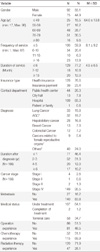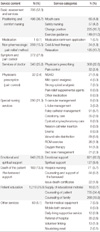1. Statistics Korea. Cause of mortality report in 2011. Seoul: Statistics Korea;2011.
2. Park JS, Oh YJ. An analysis of cancer symptoms, perceived health status, and given nursing services for community dwelling cancer patients who are registered in a public health center. J Korean Oncol Nurs. 2010; 10:48–58.
3. Kim WJ, Kim MY, Chang WY, Choi JH. Needs and satisfaction of cancer patients on the medical services in Jeju special self-governing province. Korean J Hosp Palliat Care. 2010; 13:153–160.

4. Ministry for Health, Welfare and Family Affairs. Service evaluation guide of regional cancer center. Seoul: Ministry for Health, Welfare and Family Affairs;2011.
5. Kim SH, Chung BY, Xu Y. Evaluation of a home-based hospice and palliative care program in a community health center in Korea. Asian Nurs Res. 2009; 3:24–30.

6. Cho H, Son JY, Heo JD, Jin EH. Development of an efficient management program for the home-based cancer patient management project of public health centers. Korean J Hosp Palliat Care. 2007; 10:128–136.
7. Huh JS, Kim HJ. Current status of home-based cancer patients management in Jeju. Korean J Hosp Palliat Care. 2010; 13:76–80.

8. Cho H, Son JY, Heo JD, Jin EH. A study on demand and the supply for home-based cancer patient management projects of public health centers. Korean J Hosp Palliat Care. 2007; 10:195–201.
9. Lee HS, Park SH, Chung YS, Lee BK, Kwon SH. Evaluation of a community-based cancer patient management program: collaboration between a hospice center and public health centers. Korean J Hosp Palliat Care. 2010; 13:216–224.

10. Ministry for Health, Welfare and Family Affairs. 2009 tailored home visiting health service. Seoul: Ministry for Health, Welfare and Family Affairs;2008.
11. Yun YH, Heo DS, Kim HS, Ou SY, Yoo TY, Kim YY, et al. Factors influencing terminally ill patients' pain and pain management. Korean J Hosp Palliat Care. 2001; 2:23–29.
12. Youn YH. The direction of policymaking for hospice and palliative care. Paper presented at the 2002 symposium on standardization of hospice and palliative care in Korea. Accessed August 17, 2012. Available from:
http://www.mohw.go.kr.
13. Peters L, Sellick K. Quality of life of cancer patients receiving inpatient and home-based palliative care. J Adv Nurs. 2006; 53:524–533.

14. Kim TS, Yang BK, Jeong EK, Park NR, Lee YS, Lee SK. Need assessment of home-based cancer patients. Korean J Hosp Palliat Care. 1999; 2:36–45.
15. Molassiotis A, Zheng Y, Denton-cardew L, Swindell R, Brunton L. Symptoms experienced by cancer patients during the first year from diagnosis: patient and informal caregiver ratings and agreement. Palliat Support Care. 2010; 8:313–324.

16. Yabro CH, Forgge MH, Goodman M.
EH Kim
IK Kwon
JH Kim
MI Seol
MH Chun
YH Ham
. Cancer symptom management. 3rd ed. Seoul: Hyunmoonsa;2011.
17. Morey MC, Snyder DC, Sloance R, Cohen HJ, Peterson B, Hartman TJ, et al. Effects of home-based diet and exercise on functional outcomes among older, overweight long-term cancer survivors. JAMA. 2009; 301:1883–1891.

18. Pinto BM, Frierson GM, Rabin CR, Trunzo JJ, Marcus BH. Home-based physical activity intervention for breast concar patients. J Clin Oncol. 2005; 23:3577–3587.
19. Choi JY, Kang HS. Effects of a home-based exercise program for patients with stomach cancer receiving oral chemotherapy after surgery. J Korean Acad Nurs. 2012; 42:95–104.

20. You SM. An analysis of nursing care service for low income home-based cancer patient management project in a rural community [dissertation]. Seoul: Hanyang Univ.;2008.
21. Ministry for Health, Welfare and Family Affairs. The management for home-based cancer patients. Seoul: Ministry for Health, Welfare and Family Affairs;2008.
22. De Conno F, Caraceni A, Groff L, Brunelli C, Donati I, Tamburini M, et al. Effect of home care on the place of death of advanced cancer patients. Eur J Cancer. 1996; 32A:1142–1147.

23. Ministry for Health, Welfare and Family Affiars. Administration guide of regional cancer center. Seoul: Ministry for Health, Welfare and Family Afiiairs;2011.






 PDF
PDF ePub
ePub Citation
Citation Print
Print





 XML Download
XML Download